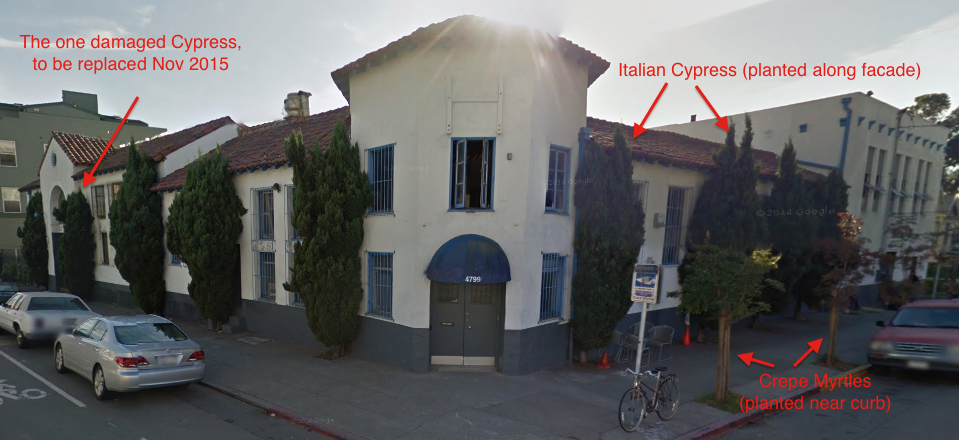Trees
Revision as of 20:28, 22 February 2015 by Dkeenan (talk | contribs) (→Care and maintenance of the Italian Cypress (Cupressus sempervirens))
This page describes how to care for the trees around the omni. Please read this entire page before attempting to prune, plant, water, move, or shape the trees.
In November 2014, a professional arborist, Molly Batchelder, came by the Omni to provide an assessment of the trees around Omni. The following is my layman's understanding her assessment.
Tree types
- The tall, mostly tubelike trees immediately along the facade of the building (along both Shattuck and 48th) are Italian Cypress (Cupressus sempervirens).
- The fledgling young trees closest to the curb/street (along 48th only) are Crepe Myrtles (Lagerstroemia).
The Italian Cypress
Care and maintenance of the Italian Cypress (Cupressus sempervirens)
- Health: All Omni's Italian Cypress are quite healthy, except for the one on Shattuck just north of the ballroom double-doors.
- Watering: Generally these mature trees do not need to be watered. Exception might be an exceptional drought condition.
- Pruning: The Italian Cypress should ideally not be pruned at all (unless the branch is definitely dead). Pruning of living branches causes the trees to grow more outward, rather than up as is their norm. And we want the Italian Cypress to grow more up than out.
- Instead of pruning, controlling their shape by wiring the branches (coated wire, netting) is reccommended.
- However, if living branches of the Italian Cypress must be pruned for whatever reason:
- the ends of branches should only be 'tipped' back
- it should be done only in the summer months
- it must be done with clean tools, disinfected between cuts (use a can of Lysol, or rubbing alcohol). Living branches should never be pruned in the winter months -- as they get cypress canker that is easily spread from tree to tree in the wet season with infected pruning tools.
- Verifiably dead branches can be removed any time of year, as long as the tools are still completely disinfected before and after every cut (with a can Lysol).
- Regular maintenance should be only:
- Thoroughly 'Shake out' all the dead needles/foliage (probably this has never been done), sweep up dead needles below when done (abates a fire hazard).
- Remove all trash stuffed into trees
- Occasional maintenance should be only:
- Gently wire in (with coated green wire) branches that are growing 'out' too much and not 'up' enough
- Examine trees periodically for fully-dead branches. Its a good idea to get a second opinion before preparing to prune any branches you think are dead, being sure to follow rigorously the above sterilization procedures.
- Can we do anything about the irregular shapes of the Italian Cypress?
- Except for gentling wiring (or netting) them in, no there's nothing we can/should do (see above for why..)
That one really messed-up Italian Cypress just north of the ballroom doors
- This tree was aggressively pruned in previous years to the point where much of it is dead that will not grow back, and the arborist reccomended removal and replacement with a 15-gallon size replacement Italian Cypress tree.
- When to to replace? Best time of year to plant trees is late in the year (November etc). The majority of root growth happens in January- February-March, so if a newly planted tree can develop a larger root system during this time, supplemental water demands in spring and summer will be less. Most likely if you plant around November, you could get by with bi-monthly watering; if you plant in the spring/summer, it is necessary to water 2-3x a week. Thus more room for failure.
Why do the Italian Cypress look a little atypical?
- The Italian Cypress no longer grow in the manner typical of Cypress in the wild, which is more 'up' than 'out' -- i.e. normally more cylindrical/conical than spherical. This change to their typical shape is due to incorrect care for the trees in previous years: The Cypress were at some point(s) in time 'topped' by the owner (apparently in an attempt to stop rats from climbing the trees to the roof). Its also probable the tools used for topping at the time were not properly sanitized beforehand, they were not pruned at the right time of year, etc. In layman's terms (the only terms in which I can speak about this), this previous topping caused the trees to basically become confused about which other branch(es) were to be the 'new' top of the tree: The topping caused a hormone to be released that in turn caused various lower branches to each think they might be the new treetop. Lower branches began to grow more outward in various idiosyncratic ways, leading to outward bulges in various places on the trees, ultimately resulting in the trees losing their typical conical shape.
- Because they no longer grow in a shape typical of Italian Cypress, these trees can easily be mistaken for Hollywood Juniper (Juniperus chinensis), which does naturally grow this way.
- Finally, the one cypress tree to the north of the ballroom double-doors was not just topped but aggressively pruned in various other places to the point where there are many dead branches and it must be replaced.
The Crepe Myrtles (curbside along 48th)
- The trainer poles and restraints on each side of the Crepe Myrtles (Lagerstroemia) are no longer necessary and if anything retard the growth of the tree at the current stage of their development. These poles should be removed, and the city called to pick up the wooden poles (do not throw away or re-use these poles please..)
- It is recommended these trees receive special structural pruning to shape their future growth, during the summer. Recommend not pruning during any other time of year.
- If you prune: Disinfect all pruning tools before and after each cut with a can of Lysol.
- More Questions?: Contact DK
